Madrid has been in my thoughts for a while. In January, close to my birthday, I found low-cost flights to Madrid and I took advantage of it. After waiting for a few weeks, at the beginning of March I went to the Spanish capital with not very high expectations, to be honest, because I had heard some conflicting opinions. Some people had told me that Madrid was a boring, somewhat austere city, where only museums were beautiful; others had told me the opposite, that it was a beautiful and fascinating city, full of things to do and see, where you never get bored. I therefore preferred to keep my expectations low to avoid disappointment. Now I tell you that I definitely belong to the second current of thought.
It was not my first time in Spain. My first trip abroad was in Iberia just 12 years ago – Oh Gosh, how time goes by! On that occasion, however, I was in the south of the country, in Andalusia, and I was fascinated by it.
Madrid in three days: my itinerary
According to the flights to Madrid I found on offer, the departure was on Sunday afternoon and return on Thursday early in the morning. I therefore had three full days. No problem if you intend to stay in Madrid the whole time, but in my (maybe crazy) plans there was also a visit to Toledo. So, before the trip I tried to plan the itinerary in the best possible way, in order to optimize my time in Madrid. I must say that I feel satisfied, because I managed to do and see everything I had planned. Here is my itinerary:
- First day: Madrid centre and Reina Sofía Museum;
- Second day: visit to Toledo and Museo del Prado;
- Third day: panoramic viewpoints of Madrid and Parque del Buen Retiro.
- You can see the video of the trip by clicking here.
Madrid in three days: day 1
Puerta del Sol
My first day in Madrid started early. At 8:00 I left from the hostal I was staying for breakfast. Unfortunately the weather forecasts had got it right and it was expected a rainy day. After breakfast, I moved to Puerta del Sol, about a 5-minute walk away. It is the most important and well-known square in tourist Madrid, but also a meeting place for Madrid inhabitants. Its name derives from the fact that the eastern gate of the city was located there along the ancient city walls. The square as we see it today is the result of a work of redevelopment of the last century.

Sol metro station
The main building of Puerta del Sol is the Real Casa de Correos. It is a baroque building in stone and red brick, built to house the central post office. During the Franco dictatorship, it became the seat of the Ministry of the Interior and the dreaded state police. Today it is the seat of the regional council of the Comunidad de Madrid. The clock tower is one of the symbols of the city and marks the official time in Spain. In front of the Real Casa de Correos you can see a semicircular stone on the floor: it is the Kilómetro Cero, considered the centre of Spain and the point from which the distances between Madrid and the other Spanish cities are measured.

Casa de Correos, Puerta del Sol
In Puerta del Sol there is another symbol of the city: the bronze statue of the Bear and the Strawberry Tree. It represents a bear that climbs up an arbutus tree. The bear symbolizes fertility and is the symbol of the city, while the strawberry tree represents the aristocracy.

The Bear and the Strawberry Tree: the symbol of the city of Madrid
In the proximity of Puerta del Sol there are several roads, many of them pedestrian, with lots of shops and places where to eat.

Puerta del Sol
Plaza Mayor
I took Calle Mayor, one of the main streets of central Madrid, which connects Puerta del Sol to the area of the Royal Palace. Arriving more or less halfway, turning left you arrive in Plaza Mayor. It looks like a square surrounded by red brick buildings and with many bars and restaurants with outdoor tables.
Centuries ago, a market outside the city walls was held here. When Madrid became the capital of Spain in 1561 (until that time Toledo had been), a redevelopment of the area was conceived, with the construction of a square for public events.
At the centre of Plaza Mayor you can see the equestrian statue of Philip III. But your attention will probably soon caught by the Casa de la Panadería: it already existed before the construction of the square and was for centuries the seat of the bakers’ guild; the frescos covering its facade today represent the zodiac signs and the allegories of time and temperature. Madrid tourist office is housed in this building on the ground floor.

Plaza Mayor


Casa de la Panadería
Plaza de la Villa
Continuing to walk on Calle Mayor, I bumped into Plaza de la Villa. Before the construction of Plaza Mayor, this was the main square of the city. In fact, the ancient town hall of Madrid is located here. The Casa de la Villa is one of the greatest examples of Habsburg architecture in Madrid. At the centre of the square is the statue of Admiral Ivaro de Bazán, winner of the battle of Lepanto against the Ottomans in 1571.

Plaza de la Villa
Cathedral of Nuestra Señora de Almudena
The rain began to fall with greater insistence, but I continued my tour, reaching the end of Calle Mayor. Right there I found the Cathedral of Nuestra Senora de Almudena.
Despite being the capital of Spain and a great empire, Madrid didn’t have a cathedral. Its construction began only in the nineteenth century, although the works lasted more than one hundred years. The first project involved the construction of a Gothic cathedral with a crypt in Romanesque style. The latter was inaugurated in 1911, while the Spanish Civil War blocked the works of the cathedral, which resumed only in 1939. When construction works started again, the French Gothic style was revalued, considered no longer adequate for the period and in contrast with the surrounding buildings. So the project was changed and construction works resumed in the 1950s. The work was finally completed and inaugurated in 1993 by Pope John Paul II.

Facade of the Cathedral of Nuestra Señora de Almudena

Side entry of the Cathedral of Nuestra Señora de Almudena



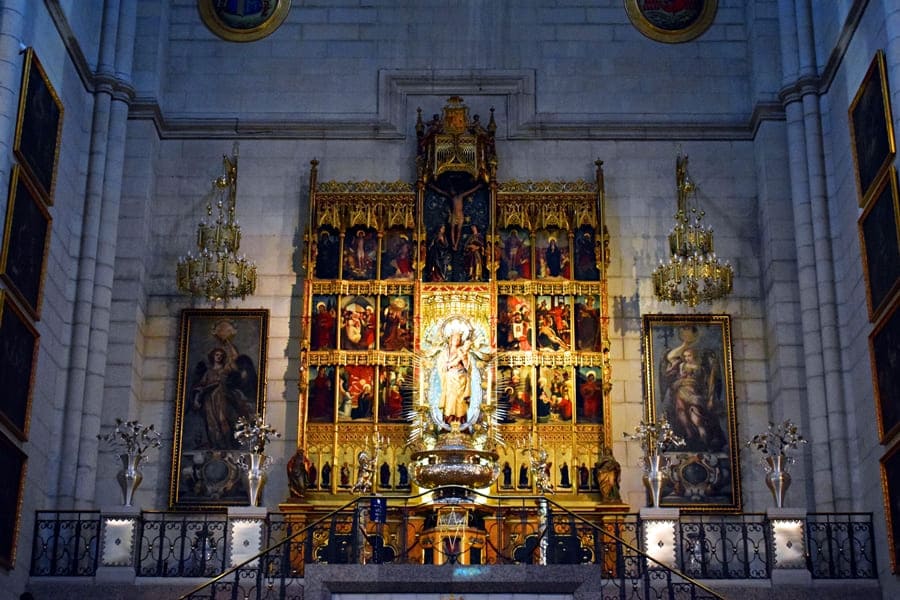

Inside the Cathedral of Nuestra Señora de Almudena
One of the most characteristic elements of the cathedral is the slate dome. It is possible to climb the dome by purchasing a cumulative ticket that includes a visit to the cathedral museum. From up there you can enjoy a 360 degree view of Madrid and see the Royal Palace from a particular perspective. Entrance to the cathedral and crypt is instead free of charge.


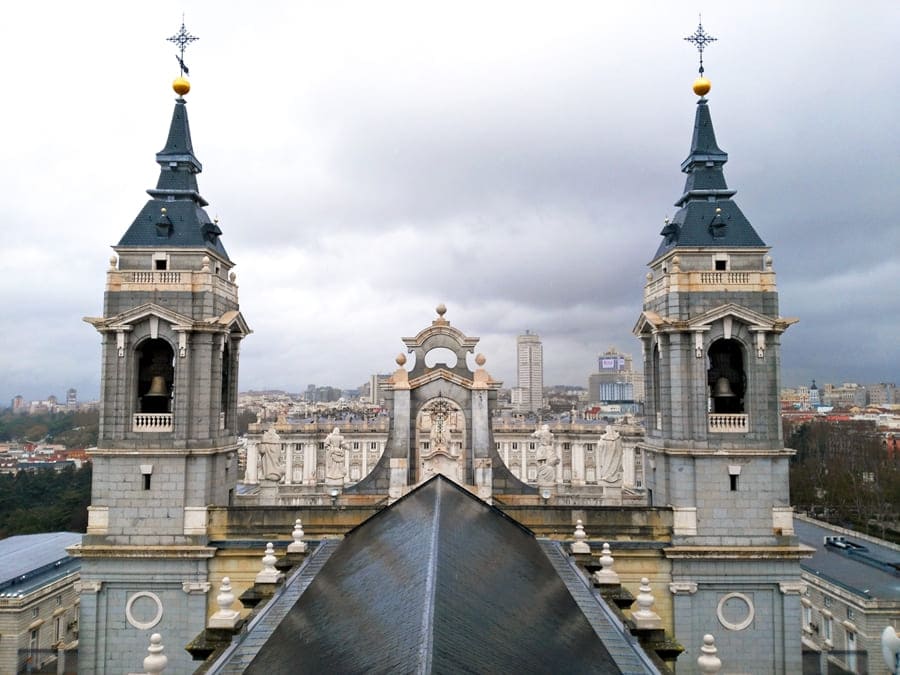
View from the dome of the Cathedral of Nuestra Señora de Almudena
The most suggestive part, in my opinion, of the Almudena Cathedral is the crypt. Admission is free, even if a donation of 1-2 euros is requested. It has more than one hundred columns, with as many decorated capitals. Both in the side chapels and on the floor, there are the tombs of members of the Madrid nobility. Despite being a real cemetery, the atmosphere inside the crypt is not oppressive and gloomy. On the contrary, the columns and the lighting make it a very suggestive place not to be missed.


Crypt of the Cathedral of Nuestra Señora de Almudena
Walking in the “Madrid de los Austrias”
Leaving the cathedral, I started a tour of the “Madrid de los Austrias“, Habsburg Madrid in practice. From the cathedral I headed to the Basilica of St. Francis The Great, at the beginning of the La Latina district. This basilica is famous for its frescoed dome, but unfortunately I found it closed. A little disappointed, I resumed my tour. Back at Calle Mayor, I intended to reach the Basilica de San Miguel before it closed at noon. Unfortunately the pouring rain forced me to stop at the Mercado de San Miguel, which I would have visited after the basilica, anyway.

Basilica de San Francisco el Grande
The Mercado de San Miguel is the last covered wrought-iron market built in Madrid in 1916. Inside, there are 33 stalls offering selected products and raw materials. All the products are exhibited in a well thought-out way, in order to appear as attractive as possible to the potential buyer and therefore to convince him/her to purchase. You can also find the typical Iberian ham, seafood from Galicia, a colorful fruit stand, bars where you can enjoy tapas and drink cerveza (beer) or Spanish wines. Today it is more like a tourist place, so as you can imagine, prices are higher than average.



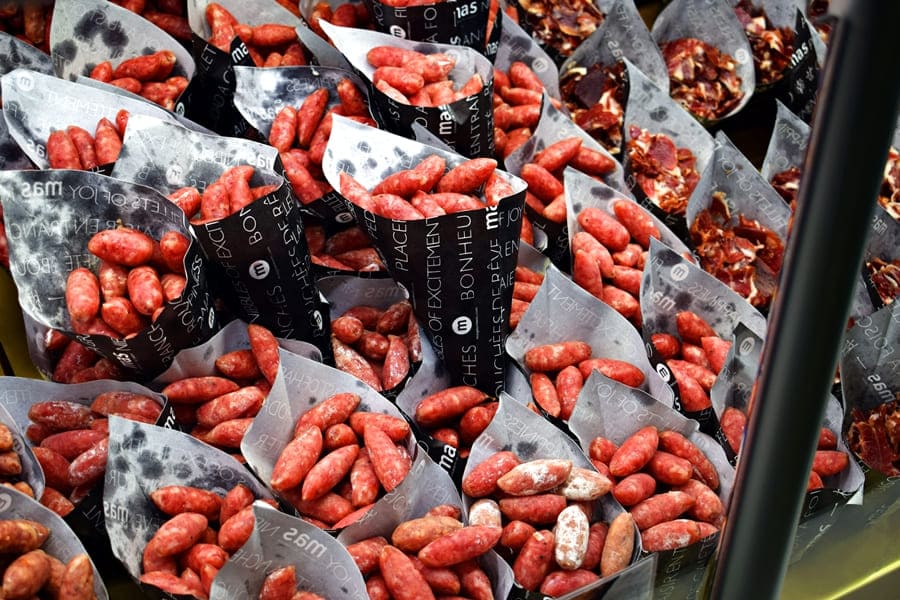
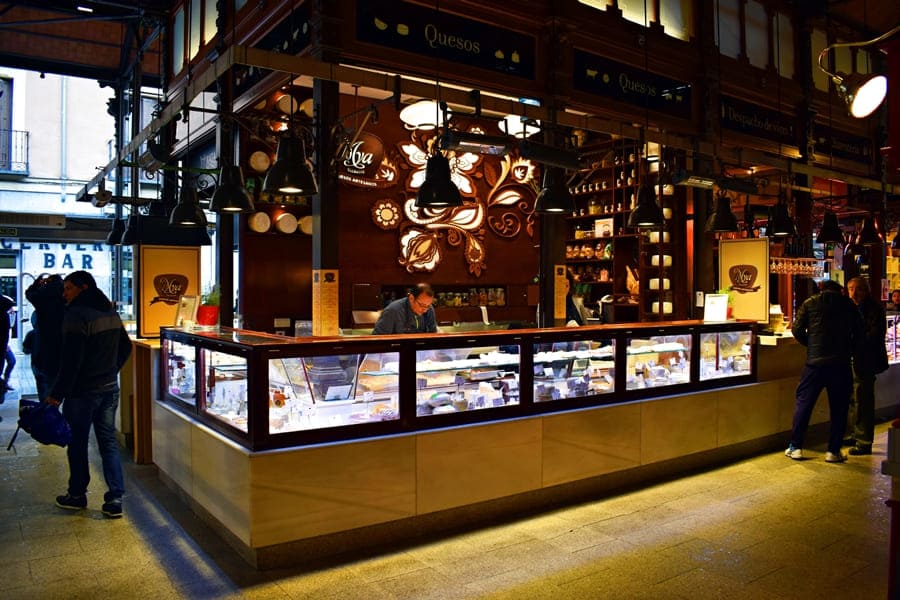
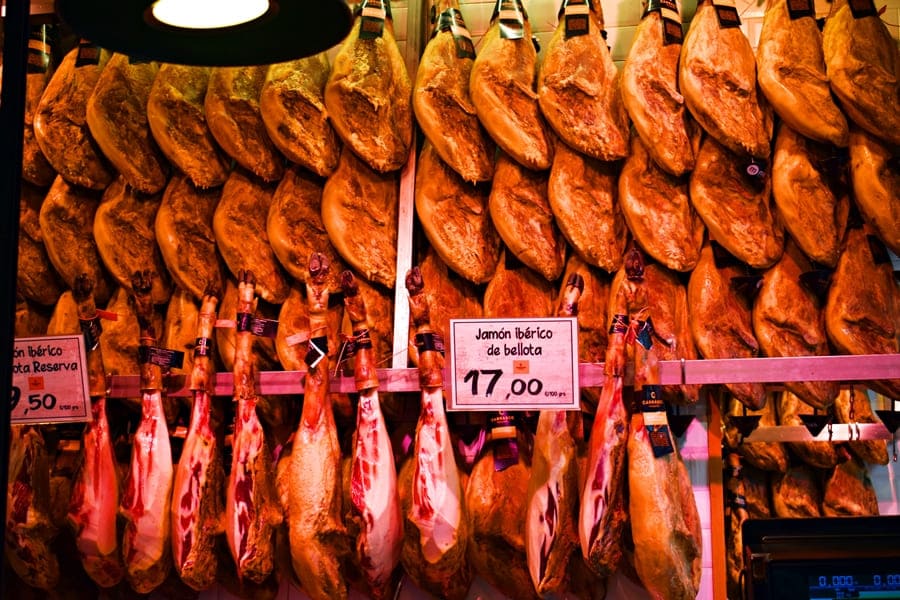


Mercado de San Miguel
As soon as the rain stopped, I started walking again. Unfortunately I found the Basilica de San Miguel closed (I went back on the third day, in the morning, but I found it closed again).
It was time for lunch and wandering through the streets around Plaza Mayor, I found a Museo del Jamon. Here the typical bocadillos de jamon iberico cost only 1 euro. An excellent solution if you want to have lunch quickly, maybe while walking.
Plaza de Oriente and the Jardines de Sabatini
With my delicious sandwich in my hand, I retraced Calle Mayor back to the area of the Royal Palace. It was around two in the afternoon and I was planning to visit the Royal Palace after 4 pm, as admission would have been for free at that time. So, I had a couple of hours to explore the area.
First I took a ride in Plaza de Oriente. This semicircular square next to the Royal Palace, was commissioned by Joseph Bonaparte, during his brief reign in Spain. Construction works began in 1811 and the area underwent drastic changes, as various buildings were demolished, including churches and even the library of the Palacio Real. When the crown returned to Spanish hands, King Ferdinand VII wanted to continue with the project to build the square. The result is a square with an English garden with stone statues of Roman and Visigoth emperors and Christian kings. They were intended for the parapet of the Royal Palace. But the king didn’t want to install them there, as he feared that they would have fallen because of their weight. On the square you can also admire the Teatro Real.

Teatro Real

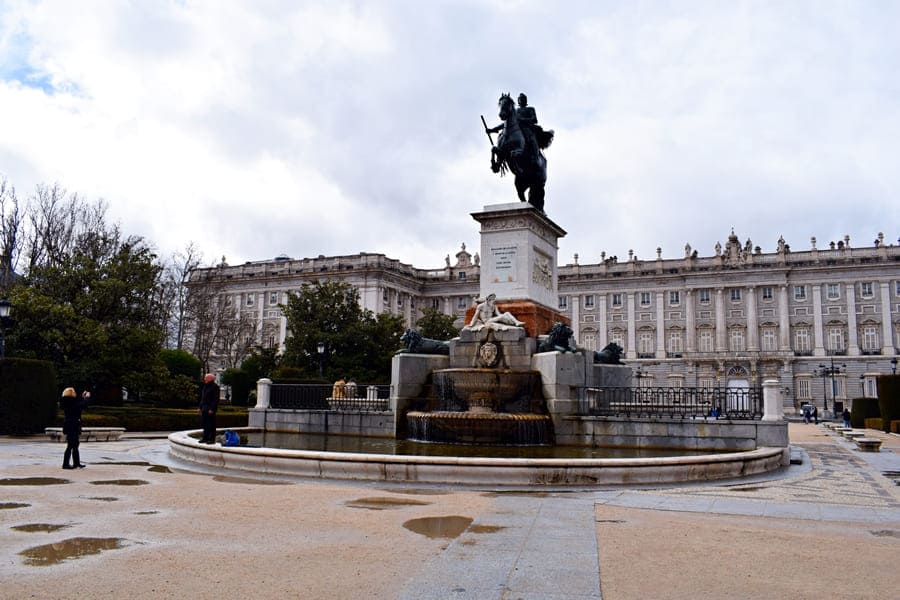

Plaza de Oriente
A little further on you find the entrance to the Jardines de Sabatini, the English gardens of the Royal Palace. There would also be the Campo del Moro gardens, but I have to admit that I forgot that day to pass by. I will go there next time!


Jardines de Sabatini
Plaza de España
Plaza de España is just a few minutes walk from the Jardines de Sabatini. It was built after Franco’s nationalists won the Spanish Civil War. The design of the square had to be imposing, in order to symbolize national greatness.
Arriving at the Plaza de España, you are immediately captivated by the two skyscrapers located on the northern and western side respectively. The first one is the Edificio España, a building of 117 metres in height and 25 floors, which has become one of the symbols of Madrid; unfortunately it was covered by scaffolding because of restoration works. The second building is the Torre de Madrid, 142 metres high and 34 floors. For several years it was the tallest building in the city.
At the centre of Plaza de España you can see the Monument dedicated to Cervantes. The writer is seated with a book in his hand. In front of him there are the bronze statues of Don Quixote on horseback and Sancho Panza on a donkey back.
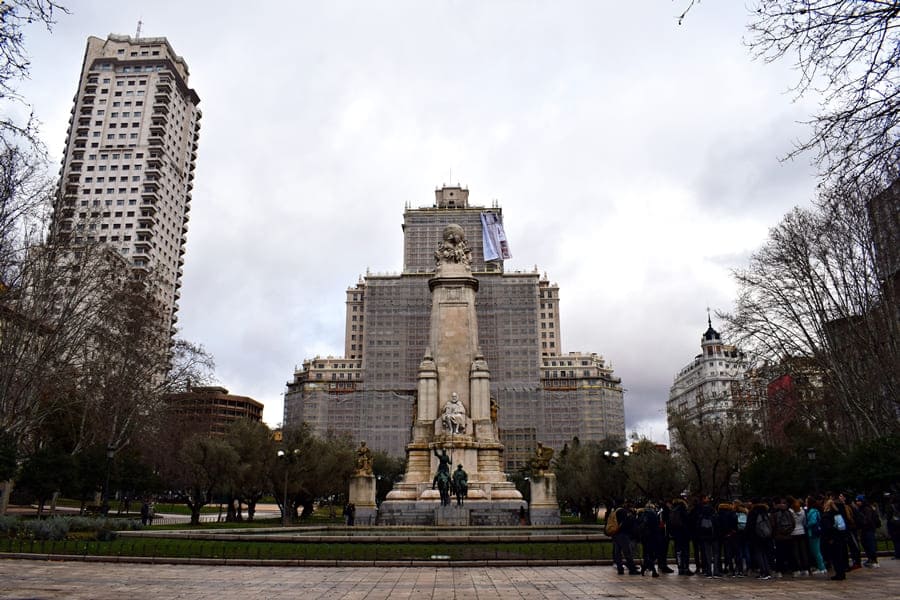
Plaza de España

Bronze statues of Don Quixote and Sancho Panza

Statue of Cervantes
Temple of Debod
Do you know that there is a corner of Egypt in Madrid? It is located just off the Plaza de España and was the next stop on my first day in Madrid. I’m talking about the Temple of Debod. But how did it end up in Madrid? When the Aswan Dam was built in the 1960s, many monuments and temples risked being submerged by water. Among these buildings, the Temple of Debod was also affected by these floods and re-emerged only during the summer season. Some Spanish archaeologists managed to save the Temple of Abu Simbel and the Egyptian government decided to donate the Temple of Debod to Spain in recognition.

Temple of Debod
The ideal would be to go and see the Temple of Debod at nightfall, because it is very suggestive with the light of the sunset. Unfortunately in those days the weather conditions were not favorable and therefore I decided to go there in the early afternoon, taking advantage of a moment of pause in the rain. Behind the Temple of Debod, there is a panoramic viewpoint, from which you can admire a beautiful view of the Royal Palace, the Cathedral of Almudena, up to the dome of the Basilica de San Francisco el Grande.

Panoramic viewpoint behind the Temple of Debod
Snack break: Chocolatería San Gines
Having eaten only a bocadillo for lunch and walked a lot, I was starting to starve. Since there was still almost an hour to 4 pm for the free visit to the Royal Palace, I decided to go for a snack at the Chocolatería San Gines to try his specialty: churros and hot chocolate. They are a specialty of Madrid and of Spain, but they say that this historic pastry shop is the best place to eat them. I found a queue at the entrance, but luckily I managed to get in and take a seat in a few minutes. What to say? The churros were very good… I state that I am a gluttonous for desserts and I eat them in industrial quantities, but maybe 6 churros for a single person are a bit too much, but I did the sacrifice! 😀
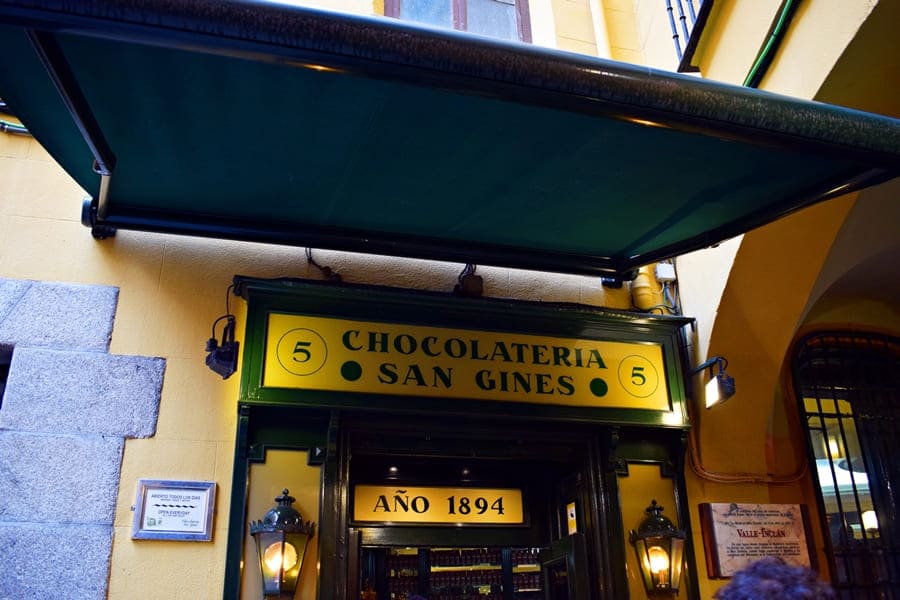
Chocolatería San Gines

Churros and hot chocolate
Royal Palace
I arrived at the Royal Palace (with a full belly) at about 15:55 and in front of the entrance I found a very long queue ending almost at the side entrance of the Almudena Cathedral. I lined up, but honestly I was very discouraged, because I thought I would have never be able to enter. Instead, within twenty minutes I had already passed security checks and started my free visit to the Royal Palace.

Royal Palace
Inside it is not allowed to take pictures or take videos, so I have no material to show you. The only environment where it is allowed is the large entrance staircase, designed by Sabatini.
The construction of the Royal Palace dates back to the mid-18th century, where the ancient Arab Alcazar was located. King Charles III was the first to use it as a royal residence. The initial project was carried out by Filippo Juvarra, although after his death it was modified and carried out by his pupil Giovanni Battista Sacchetti.
Inside the Royal Palace
The Royal Palace has about 2800 rooms, of which only a small part can be visited. The complete tour takes about 45 minutes, passing through copiously decorated rooms, which prove the greatness of Spain in past centuries.
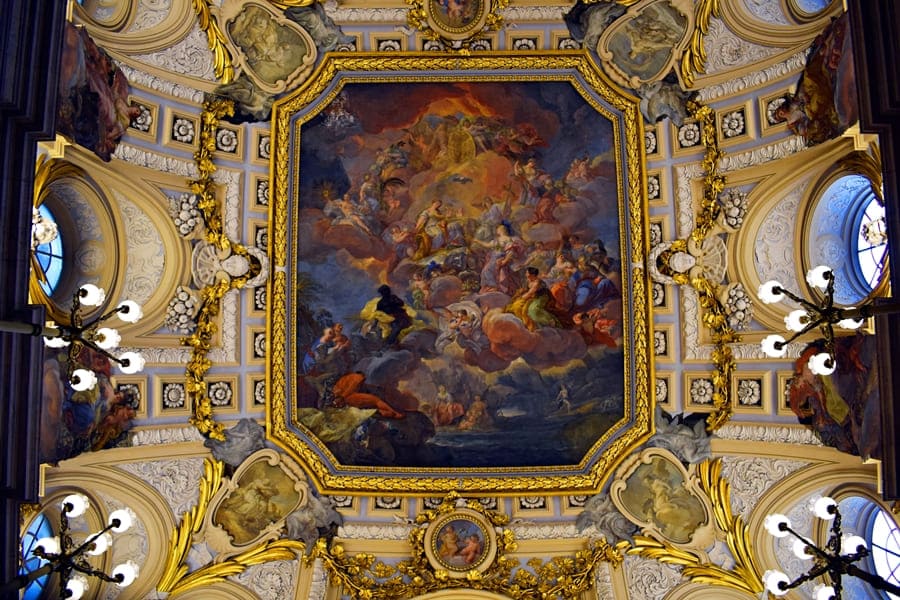



Staircase of the Royal Palace
After the great staircase, you enter the Halberdier’s Room, used by the royal guard and decorated with tapestries on the walls and a fresco on the ceiling made by Giovanni Battista Tiepolo. The Throne Room has also a ceiling frescoed by Tiepolo, depicting the allegory of the power of the Spanish monarchy. The two thrones were made for King Juan Carlos and Queen Sofia in 1977 and present their portraits.
We move on to the King’s Apartments, which belonged to Charles III, the first monarch to reside in Madrid Royal Palace, and richly decorated: the king’s bedroom with its blue walls is very beautiful. The Porcelain Room has walls completely covered with porcelain panels, depicting Bacchus, and was the place where men smoked while women entertained themselves in the adjacent Yellow Room.
Two rooms left me literally speechless. The first one was the Banqueting Room, richly decorated with stucco and porcelain, where the perfectly set table is illuminated by 25 chandeliers and can accommodate up to 144 people. The second is the Capilla Real (Royal Chapel). It has a single nave supported by black marble columns and a completely frescoed ceiling.
During the visit you can also see the autograph documents of the abdication of King Juan Carlos and the speech of proclamation of his son, the current king Philip VI.
Reina Sofía Museum
Once out of the Royal Palace, the sun and the blue sky had made space among the threatening clouds. It was around 5:20 pm and my next stop for the day was the Reina Sofía Museum, with free entry from 7 pm. I had more than an hour and a half and I therefore decided to reach it on foot, in order to see other corners of the city.
Arrived in front of the museum, I lined up. At exactly 7 pm the staff opened the access for free admissions and in a few minutes I was already inside. The Reina Sofía is a museum of contemporary art and its permanent collection of about 500 works is displayed on two floors. If you want to follow the visit in a chronological order, you’d better start from the second floor, where works from the period before the Second World War are exhibited in room 1.
The route continues until you reach rooms 5 and 6 entirely dedicated to Pablo Picasso. There you can admire the most famous work preserved in this museum: Picasso’s Guernica. Unfortunately it is strictly forbidden to photograph the work. Two members of the staff stood at both side of the Guernica to check nobody would take pics. Continuing the path you can admire other works, including some by Salvador Dalí, Joan Mirò and many others.
My first day in Madrid ended with the visit to the Reina Sofía Museum. After the museum I went to dinner at the Museo del Jamon (where I had bought the bocadillo for lunch) and there I had dinner spending just over € 10, a beer included (33 cl).
Madrid in three days: day 2
My second day in Madrid started very early because I had planned to spend the day in Toledo. I’m talking about my day in Toledo in another post.
I returned from Toledo by the 5:25 pm train, arriving at the Atocha train station a few minutes before 6 pm. Just in time to go to the Prado Museum, taking advantage of the free admission time. But first I stopped to take some pictures of the tropical garden located right inside the train station. Even if you don’t have to use trains during your trip to Madrid, I recommend going to see it.


Tropical garden at Atocha train station
Prado Museum
Once I arrived in front of the Prado Museum, I found a very long queue. It was already 6:20 pm and I thought I wouldn’t have been able to enter. As it had happened at the Royal Palace the day before, I managed to get in a few minutes, so don’t be scared if you find a long queue!

Museo del Prado
I start by saying that a proper visit to the Prado Museum takes several hours, if not almost a whole day, especially if you love the genre. Mine was a one-hour visit only. I know that for many of you this thing will sound like a heresy, but my relationship with art galleries is not idyllic. I can’t stay there for so many hours, I can’t help it! 😀
However, with the map of the museum in hand, having little time and being very tired due to the many kilometers on foot in Toledo, I went in search of the most famous paintings on display: among them the Madonna of the Fish and Portrait of Cardinal by Raphael, David and Goliath by Caravaggio, the Christ in piety and an angel by Antonello from Messina, the Bacchanal of the Andrii, Charles V in Mühlberg and the Danae by Titian, just to name a few. Then there are works by Tintoretto, Veronese, El Greco, Velázquez, Goya, Tiepolo, Ruben, and many others.
If you want to visit the Prado Museum without time constraints, I recommend buying the Madrid City Pass, a card that includes discounts on various attractions and the skip-the-line ticket for the Prado Museum. For more information on the card, click here.
Madrid in three days: day 3
Finally, after 2 days of rain, a beautiful sun was shining in Madrid. For this reason I decided to live the day in a much more relaxed way, trying to enjoy the city as much as possible.
I started from the hostal I was staying to the Faro de Moncloa, in the western part of Madrid. It is not right in central Madrid, but about 3.5 km from the Gran Via metro station. I decided to reach it on foot, because I wanted to observe the city while walking. It was nice to see even non-tourist areas of Madrid.
Faro de Moncloa
The Faro de Moncloa is a lighting tower installed in 1992, when Madrid was the European Capital of Culture. With its 92 metres it stands in the centre of the university district, next to the Museo de América, which displays many pre-Columbian and colonial finds. I admit that I wanted to visit it, but I had promised myself that day to enjoy the city and stay in the open air as much as possible.
So I just climbed the viewing platform of the Faro de Moncloa. From up there you can enjoy a 360 degree view of the city. That morning, fortunately, there was no haze and therefore the mountains of the Sierra Guadarrama were visible, in addition to the various main buildings of the city. Inside the platform there are explanatory panels showing the various monuments and buildings visible from the tower.


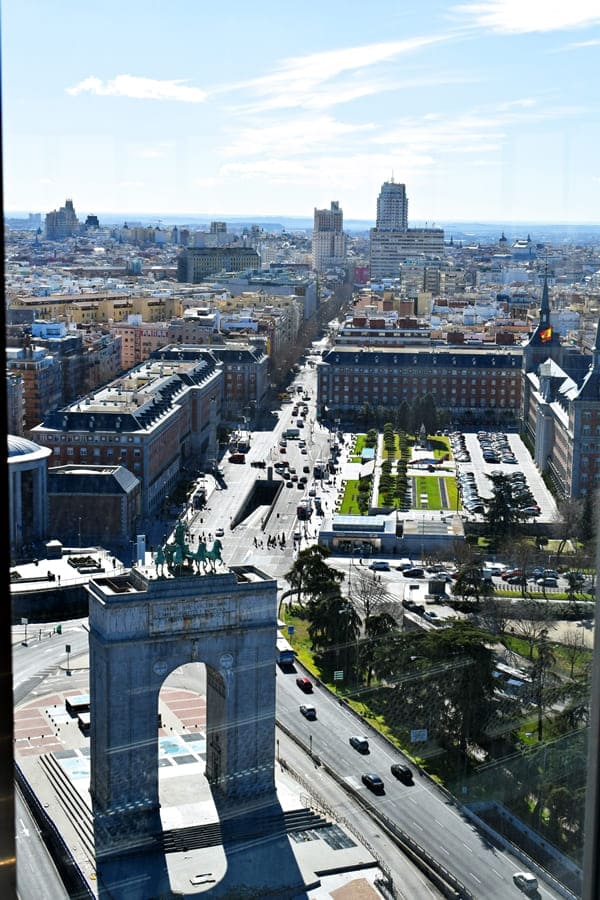

noramic view from the Faro de Moncloa
Panoramic viewpoints of the Gran Via

Gran Via
Once off the lighthouse, I walked back to the Gran Via. I stopped at the El Corte Inglés shopping centre next to the Callao metro station. I had no intention of doing any shopping, but I went up to the ninth floor of the mall, where in addition to various bars and eateries, there is a panoramic terrace from which you can enjoy a beautiful landscape over the city.


View from El Corte Inglés shopping centre
After taking my photos, I went down and moved to the Círculo de Bellas Artes in Calle de Alcalá. There it is possible to go up on its terrace (azotea), paying a ticket of 4 euros. It’s worth the cost, because the view is breathtaking – the most beautiful one seen during that trip. The terrace is also very nice, because there’s a bar with tables and a relaxation area with deck chairs.



View from the panoramic terrace of the Circulo de Bellas Artes
It was lunch time and the long morning walk had made me so hungry. I moved to Plaza Mayor, where nearby, on Calle Botoneras, there is a place that prepares the typical bocadillo de calamares, according to many the best in Madrid. I consumed my bocadillo resting on a column in the Plaza Mayor, sharing it with the sparrows approaching my feet, waiting for me to throw the next crumb at them.
Afternoon at the Parque del Buen Retiro
With a full stomach, I resumed my ride. That beautiful sunny day couldn’t but include a relaxing walk to the Parque del Buen Retiro. Along the way I passed by Plaza de Cibeles, where the fountain of the same name and the beautiful Palacio de Comunicaciones are located. Unfortunately the palace was covered by scaffolding. Also that building has a panoramic viewpoint, but at that moment it was closed for restoration works. A little further on I passed in front of the Puerta de Alcalá, before entering the park.

Puerta de Alcalá
The Retiro Park is the green lung of central of Madrid, a very nice park offering a space of over 125 hectares to relax, play sports and have fun. Entering from the north-western entrance near the Puerta de Alcalá and along the main avenue, Avenida de Méjico, you almost immediately encounter the Fuente de Galápagos, a fountain decorated with turtles, frogs and dolphins commissioned by King Ferdinand VII on the occasion of the Isabella’s first birthday.

Fuente de Galápagos
A little further on you see the Gran Éstanque, a rectangular-shaped artificial lake, where you can also take a rowboat ride. The lake is dominated by the Monument to Alfonso XII, consisting of an equestrian statue of the king and a semicircular colonnade.

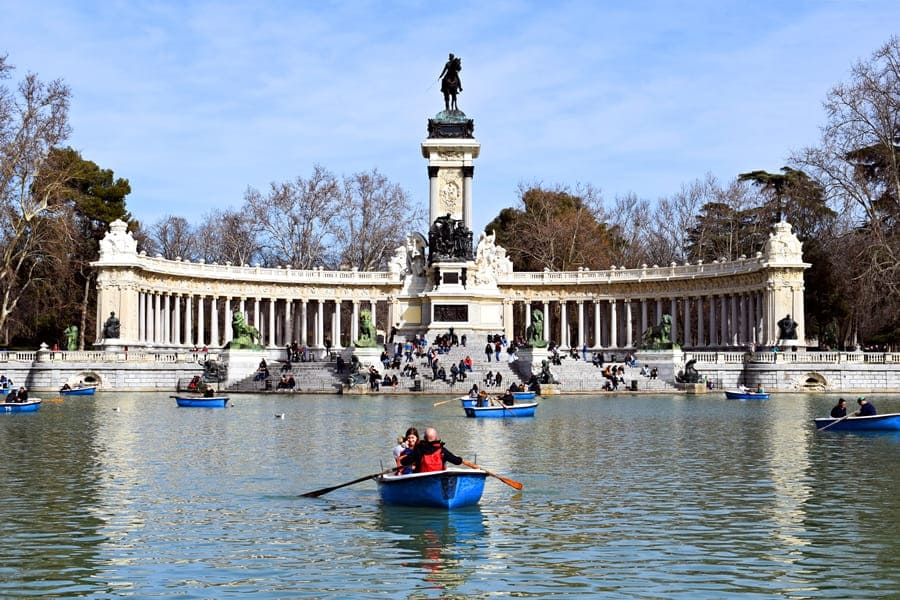
Gran Éstanque
Continuing the walk, I saw the Fuente de la Alcachofa and Palacio de Velázquez. This red brick building, with coloring tiles and arches, was designed by Velázquez to host a mining fair in 1883. Today it is used as an exhibition space.
Not far away there is another building by Velázquez: the Crystal Palace. It was built in 1887 to house plants and flowers from the Philippines and overlooks a small lake. It was built with an iron and glass structure, inspired by the Crystal Palace in London.

Fuente de la Alcachofa

Palacio de Velázquez

Crystal Palace
I continued my tour to the Fuente del Angel Caído (Fountain of the Fallen Angel), inspired by the Lost Paradise by John Milton. In fact it represents the fall of the angel Lucifer, chased from Paradise for having challenged God.

Fuente del Angel Caído
My last hours in Madrid
With the Retiro Park my exploration of Madrid ended. I spent the late afternoon wandering around, looking for souvenirs and then immediately back to my room after dinner. Unfortunately my return flight was scheduled at 7:10 am, so I should have taken the night bus to Madrid airport at 4:30 am.
As I said at the beginning, I had heard mixed opinions on Madrid, but I must say that it passed the test with flying colours. Oh I forgot! I want to clarify that in this itinerary I didn’t even catch a bus (except for the journey to/from the airport), nor a metro train. To be honest, I have no idea how the metro looks like in Madrid! 😀















Leave A Reply